Last Updated on February 21, 2022 by Heather Hart, ACSM EP, CSCS
Ultramarathon reality check: it seems like the further you run, the more gear you’re going to need. If you’re new to the trail and ultra scene, you may be wondering if trekking poles are an integral piece of running equipment that you should invest in. The answer, of course, is “maybe”.
As with everything, there are pros and cons to running with trekking poles, and your need for them may be based on not only personal preference, but a case by case (and race by race) situation.

Trekking poles have become increasingly popular among runners, so much so that many companies now make running specific poles. These poles tend to be lighter than traditional hiking poles, and often fold up so they can easily be carried in a hydration pack when not in use.
The obvious con here, however, is that they are still another bulky piece of gear that you need to carry. So do you REALLY need them? Let’s break it down – just like a convenient Z- pole
Pros & Cons of Running with Trekking Poles

Bottom row: aluminum generic telescoping poles (hiking or running). These typically retail for around $30. Both are equally as useful.
Pro: Take A Load Off!
Trekking poles allow you to distribute some of the workload from your legs to your arms. This is extremely helpful in delaying fatigue when climbing and descending, both of which can be very taxing to your leg muscles (as any runner who has tackled some crazy vert will assure you).
Think of it like utilizing the banister on a staircase to help push yourself up the stairs with your arms, rather than relying solely on your leg muscles.
Further, during later stages of an ultra when your feet are absolutely beat up, running poles can help take pressure and weight off of your lower body. Elevation or not: your tired, swollen feet will thank you.
Con: Some Upper Body Strength is Required
While trekking poles aren’t heavy (mine weigh in at a measly 230 grams, or about a half of a pound each) the repetitive motion of the forward swing, plant, and lift of trekking poles may be more upper body movement than you are typically used to while running.
I hate to list this as a “con”, because I truly love to see all runners strength training their entire bodies. However, if you don’t, you’ll likely notice the use of these muscles if using running poles for an extended period of time.
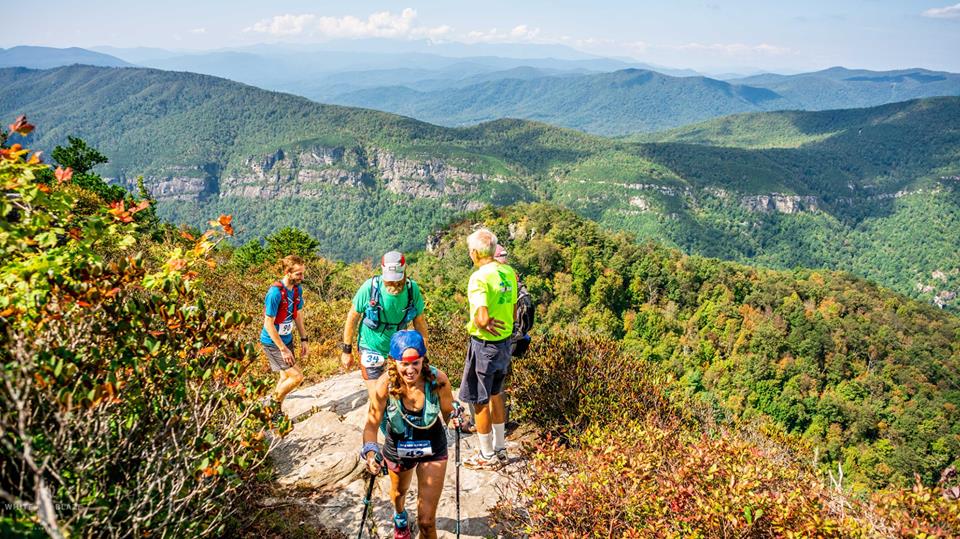
Pro: Increase Balance & Confidence
Climbing or descending gnarly, technical terrain can be intimidating for those of us born without mountain goat legs (I’m looking at you, Killian). Finding – and trusting – balance on uneven terrain can be physically and mentally exhausting. Trail running poles give you four points of contact with the ground- your feet and the poles – which can lend to better balance.
Mountains aside, poles can also be used as a point of solid contact in mud, swamps, snow, or other soft terrain.
Con: There’s a Learning Curve
Trekking poles look simple enough to use, but ask any runner about the first time they attempted to run with poles, and they will assure you that they can definitely feel awkward at first.
Between finding the correct height and comfortable position for your body, to figuring out a continuous movement pattern that helps – not hinders – your movement, trekking poles can definitely require a little practice.
You also learn over time what sort of terrain your trekking poles will work well on (dirt, gravel, etc.) and what sort of terrain they may slip on (solid rock).
And don’t forget trying to maneuver the aid station snack table with poles in your hands, or how to hold them when running. Therefore, I always recommend you practice with your ultrarunning poles during training, before relying on them during a race.
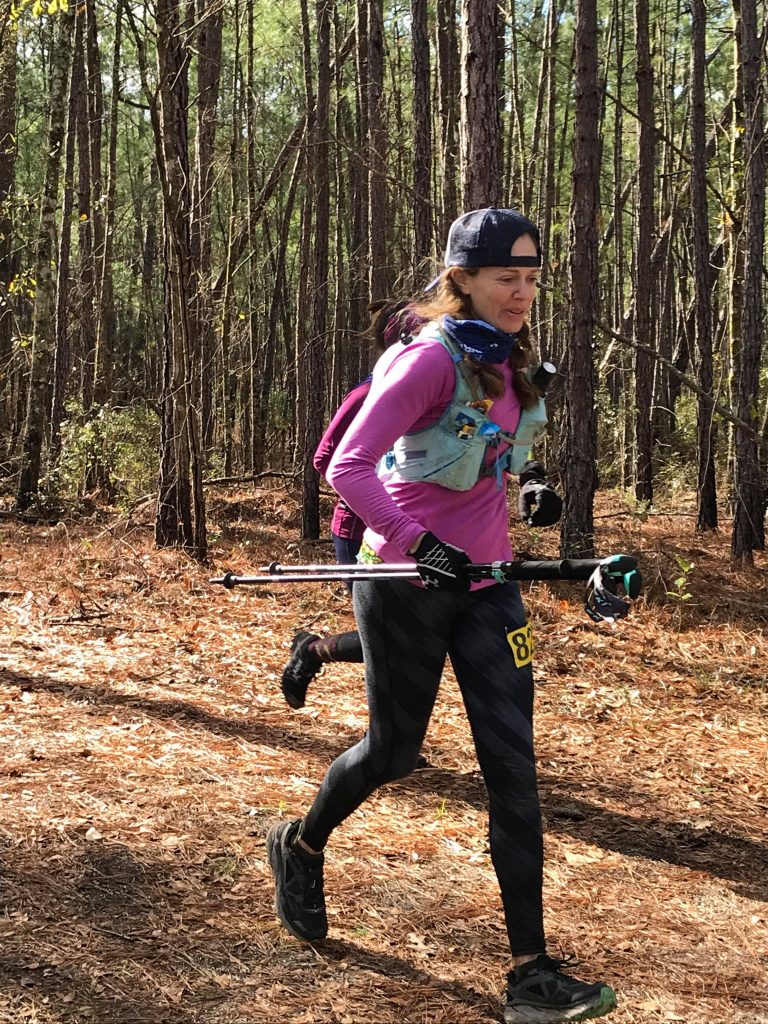
Trekking poles, especially when fitted correctly, can help runners maintain a better, more upright posture. Fatigue – whether from climbing, carrying a hydration pack, or simply covering long distances – often causes runners to hinge forward at the waist and lean forward. (So does a weak core and back, so don’t skimp on your strength training). Maintaining upright posture can help prevent low back pain, shoulder pain, or other issues associated with bad posture.
Pro: Better Posture
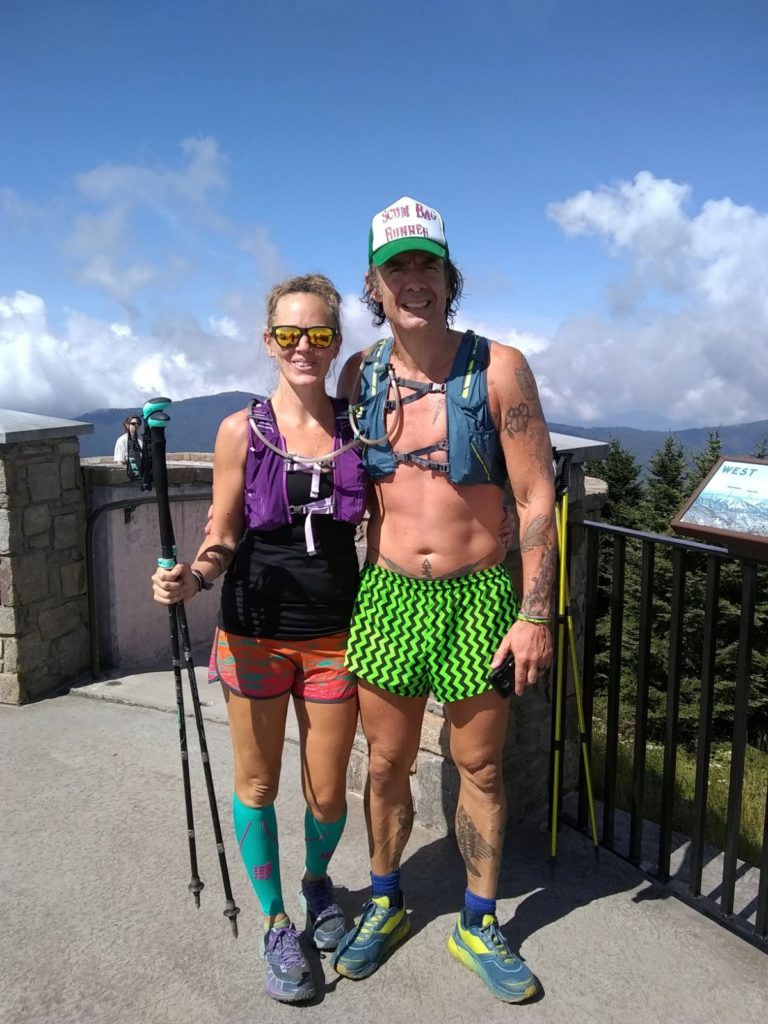
Con: They CAN Be Dangerous.
Let’s face it, most things can be dangerous when used improperly. But trekking poles fall into the “you’ll shoot your eye out, kid!” level of potential danger.
In various races, I’ve seen people swing poles too far back and hit other runners (hell, I got hit incessantly with them during Stage 2 of the TransRockies Run). I’ve seen people lean their body weight into a pole, only to have the pole slip. They are essentially a giant, sometimes sharp stick that you run with.
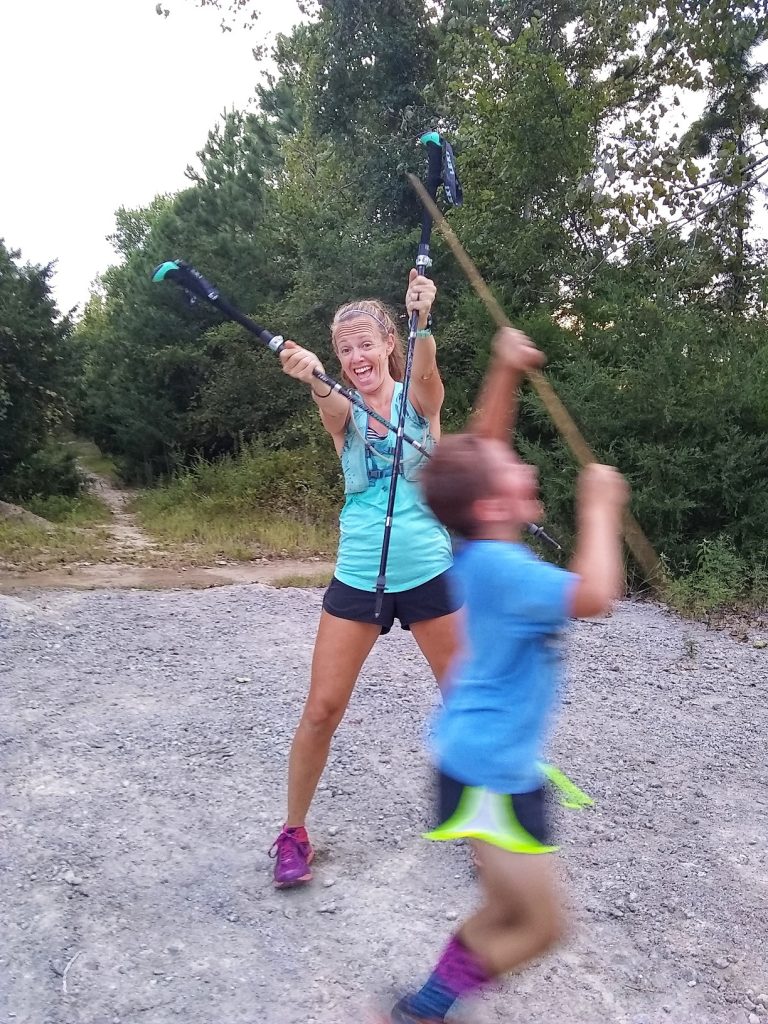
Pro: Multiple Uses Besides Running
The possibilities for trekking pole uses are only limited by your imagination. While I hope that you don’t have to use your trekking poles for any of the following, they could potentially be used for:
- Self defense (against the likes of bees, bears, boars – just kidding. Don’t poke any of those with your trekking poles.)
- Retrieving a lost shoe from a river.
- Building a shelter or tent.
- Cooking s’mores or hot dogs over an open flame.
- A splint, after you broke your leg because your running poles made you TOO confident on the downhills.
Cons: Trekking Poles Might Not Be Allowed
On a more serious note, always check with race rules before assuming that trekking poles are acceptable. Just like earbuds and strollers, some race directors don’t allow trekking poles for various reasons – be it a safety issue or simply because the race director doesn’t think you “need” them.

Do You Need Trekking Poles?
In summary: do you need trekking poles? NEED is a strong word. Athletes can – and have – survived incredibly arduous mountain courses without poles. However, for longer distances courses or even stage races with a lot of vertical gain, trekking poles can be an incredible way to offset and delay fatigue.
Find a friend that owns a pair, ask to borrow them for a training run, and see if trekking poles are right for you!
Running Poles FAQ
Now that we’ve got the pros and cons of running with trekking poles out of the way, if you’re ready start shopping for, training with, and racing using poles, here’s what you’re going to need to know:
7 Tips for Choosing Trekking Poles for Ultramarathon & Trail Running:
Not all running poles are created equally, so it’s important to know what sort of features you are looking for when you start shopping. Technically speaking, there are many types of poles created for different sports, from running to snowshoeing, hiking to skiing, and Nordic walking, which is a specific walking technique.
- Make sure you get the correct fit for your needs. Trekking poles are not a one size fits all piece of gear.
- For trail or ultrarunning, you’ll want to opt for collapsible folding or telescoping poles. Having the ability to collapse the pole down means it will fit in your hydration pack when you aren’t using them, so you don’t have to carry them. In fact, many hydration packs have straps built in for this specific purpose.
Depending on the course, you might not always need to run with poles. So, non collapsible poles can be a huge pain over ultramarathon distances - Lighter is usually better. While the difference of a few ounces may seem trivial, over the course of an ultramarathon, all the extra weight you carry adds up. Lightweight poles designed specifically for running can help make a difference over long distances.
- Consider your terrain. When deciding what material to get (carbon fiber, aluminum, etc.) consider the terrain you’ll be running on. While carbon fiber certainly is lighter, if you run on really rocky terrain, there is a greater chance you may snap the poles if they get caught between rocks.
- Make sure the grip is comfortable. Running poles come with a variety of material grips, such as foam grips, cork grip, or even firm rubber grips. Everyone will have different preferences here, so there is no right or wrong.
- Remember, more expensive is not necessarily better, especially if you don’t plan to use your trekking poles very often. My husband uses a $20 pair of running poles he purchased at a chain store, while I splurged years ago and bought myself a pair of carbon fiber Leki poles. Spoiler alert: my expensive poles have not given me an advantage over him. A lot of the less expensive poles are still very light weight and sturdy.
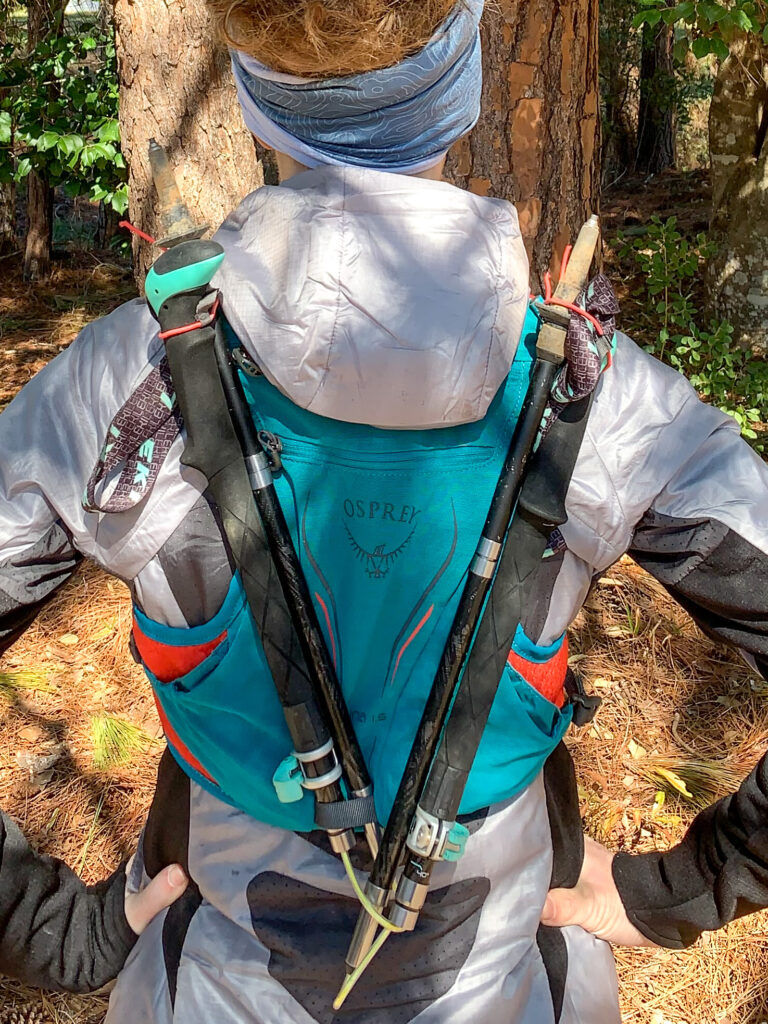
What Length Should the Running Poles Be?
The length of your running poles will be based upon your height. Ideally, when standing on flat ground, you can hold your arms at your sides, elbows bent at a 90-degree angle, with your hands on the trekking pole grips, and the pole tips on the ground.
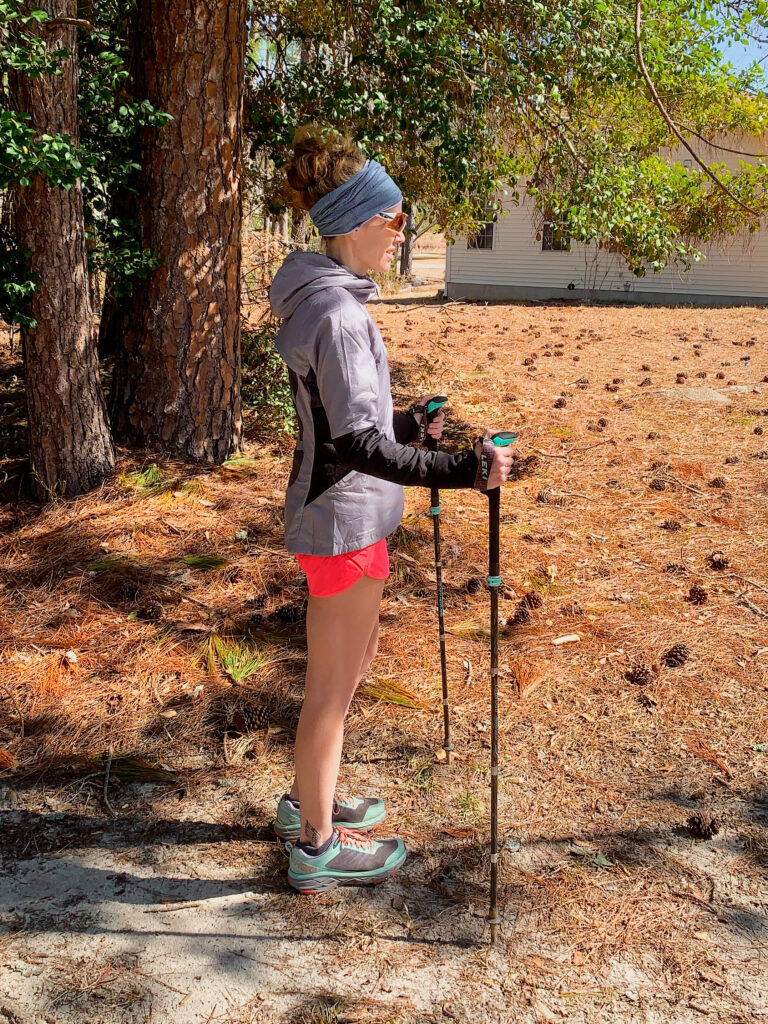
This will vary slightly based on individual preferences. As you can see in the photo above, my wrists are more comfortable with the trekking poles adjusted so my elbows are just slightly beyond 90 degrees.
Almost all trekking poles on the market have an adjustable range, but they are not a one size fits all item. It’s important that you find the right size for your height. If you are on the very edge of a range, I highly suggest going to a store that sells specifically trail / ultrarunning poles to find what works best for you.
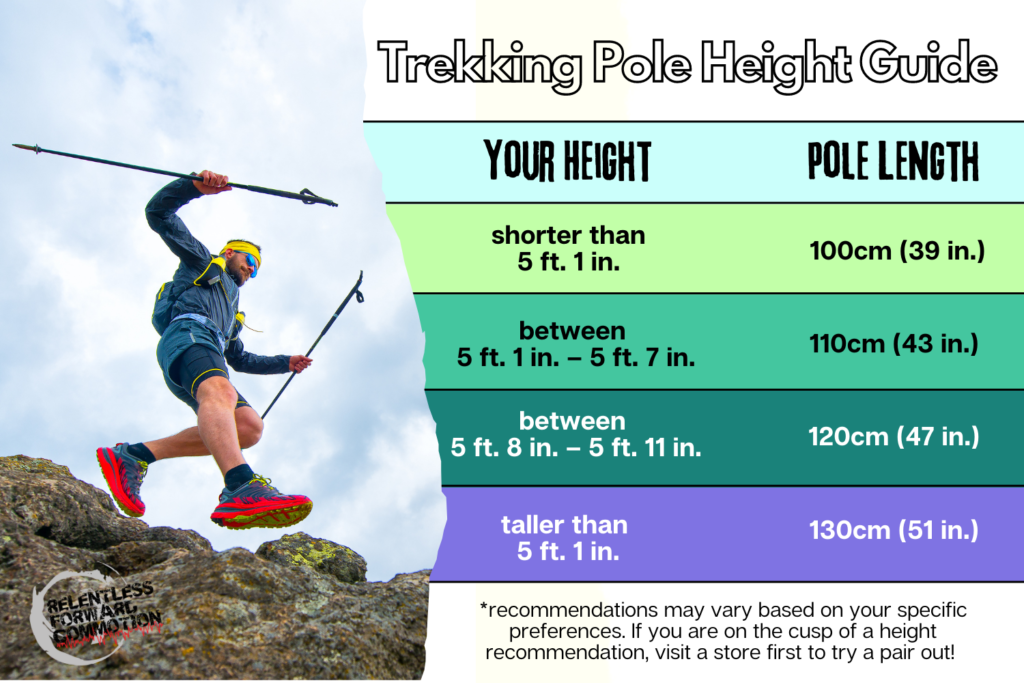
How Do You Adjust the Height of Trekking Poles Based on Terrain?
Adjusting the height of your trekking poles based on various terrain can make running with the poles more effective. Of course you aren’t going to want to stop and constantly adjust them mid run or race. But, if you have long, steep sections of uphill or downhill, adjusting your trekking poles can make using them easier and more comfortable.
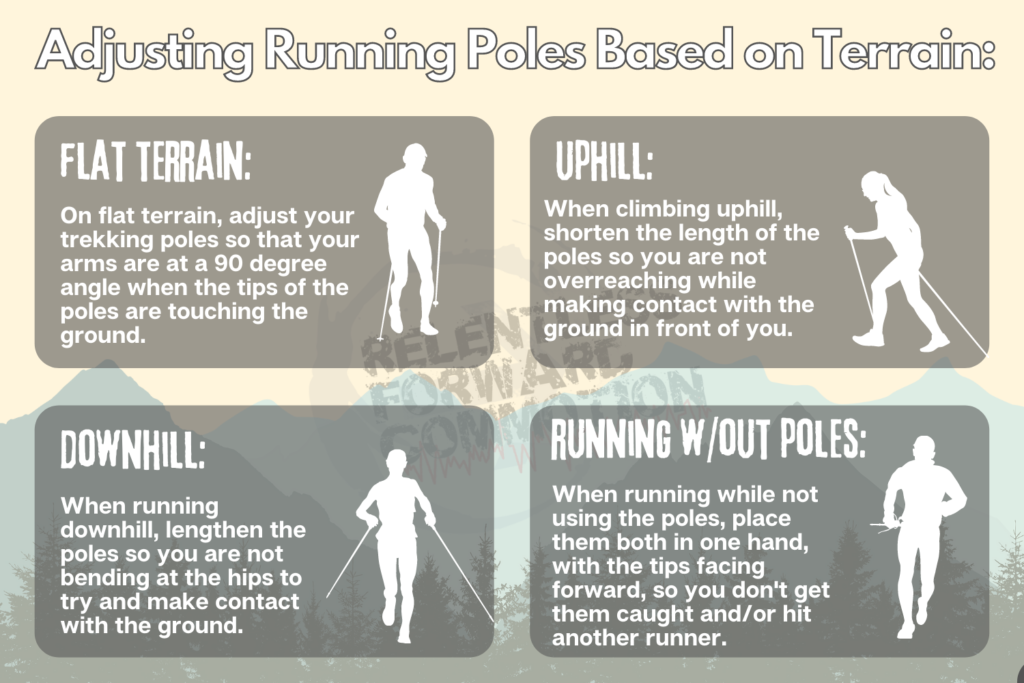
Trekking Pole Height While Running on Flat Terrain
On flat terrain, adjust your running poles so that your arms are at a 90 degree angle when the tips of the poles are touching the ground.
Trekking Pole Height While Running Uphill
When running (climbing, hiking) uphill, you’ll want to shorten the pole length so you are not overreaching while making contact with the ground in front of you.
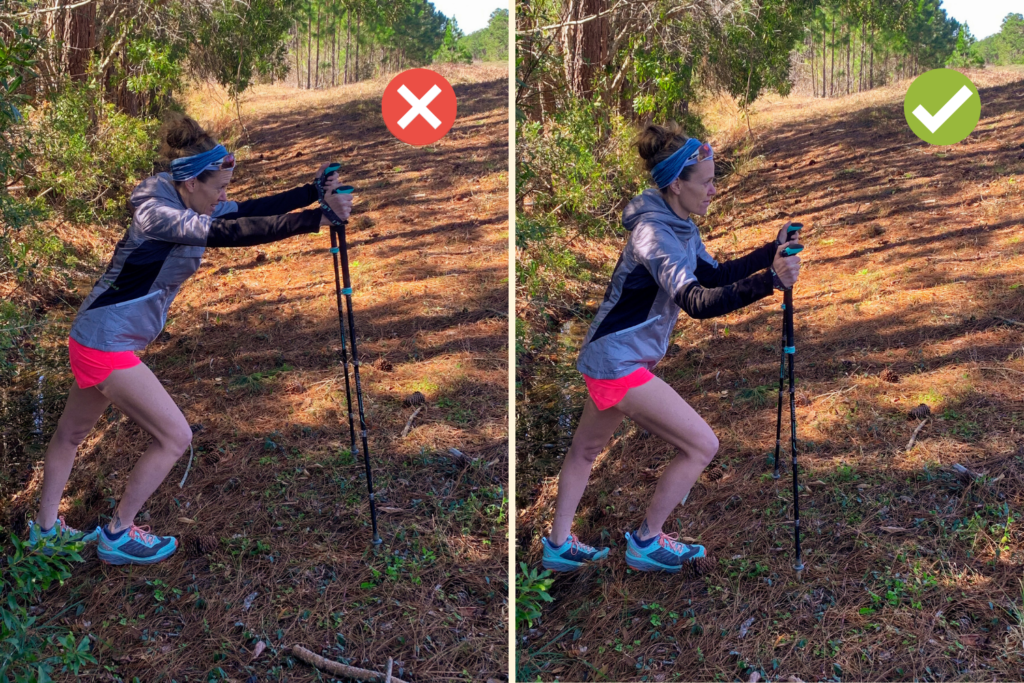
Trekking Pole Height While Running Downhill
When running downhill, lengthen the height of your trekking poles so that you are not bending at the waist or unnaturally reaching down to try and make contact with the ground.
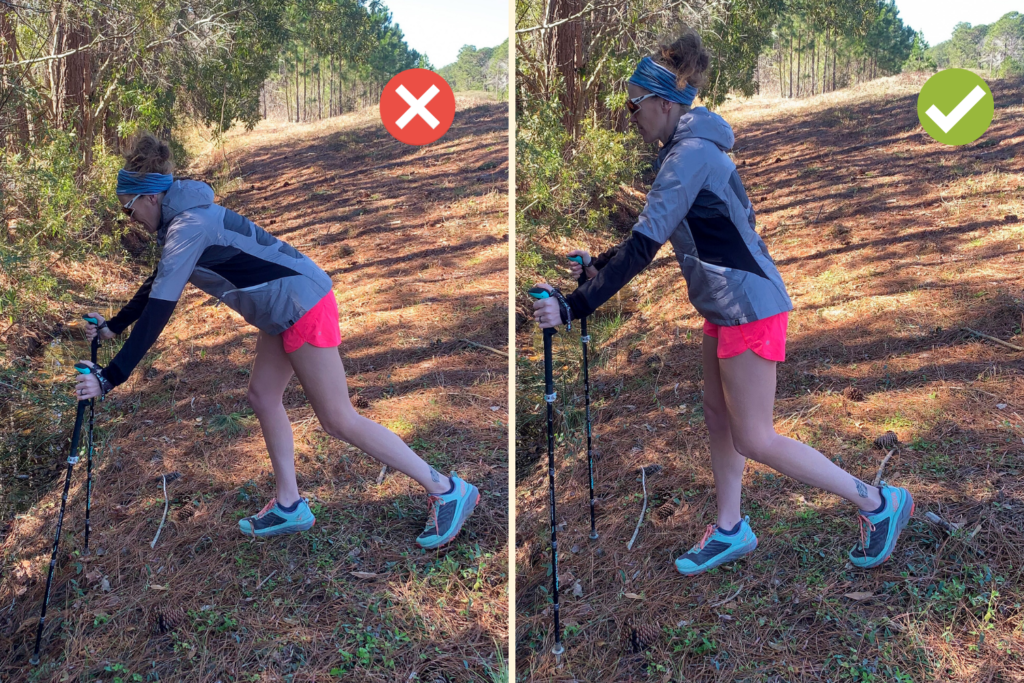
Should I use Trail Running Poles for an Ultramarathon?
Because the poles help evenly distribute your body weight, and take pressure and weight off of your lower body, they can help delay the onset of fatigue during an ultramarathon. Not to mention, many mountain ultras include large amounts of vertical gain and loss, so poles can assist with steep climbs and descents.
And lastly, when everything hurts in the later miles, trekking poles can act as a form of joint support and stability for your aching body. You don’t need to be running a mountain race to experience that relief!
Again, not all races allow trekking poles. So double check with the race director of your goal ultramarathon to ensure the use of poles is allowed. (The same goes for any mountain or trail race, regardless of distance.
The 7 Best Trekking Poles for Ultrarunning & Mountain Runners
The best trekking poles for ultrarunning are going to be the ones that work the best for you. That said, according to the trail and ultra runners I polled here are the most popular running poles:
- Leki Micro Vario Carbon poles (also available in a women’s specific version)
- Ultimate Direction FK Ultra Lightweight Carbon Poles
- Black Diamond Distance Z & Black Diamond Distance Carbon Z
- Leki Micro Flash Poles
- Leki Micro Trail Pro
- Salomon Sense Ultra Foldable Poles
- MSR DynaLock Ascent foldable carbon poles
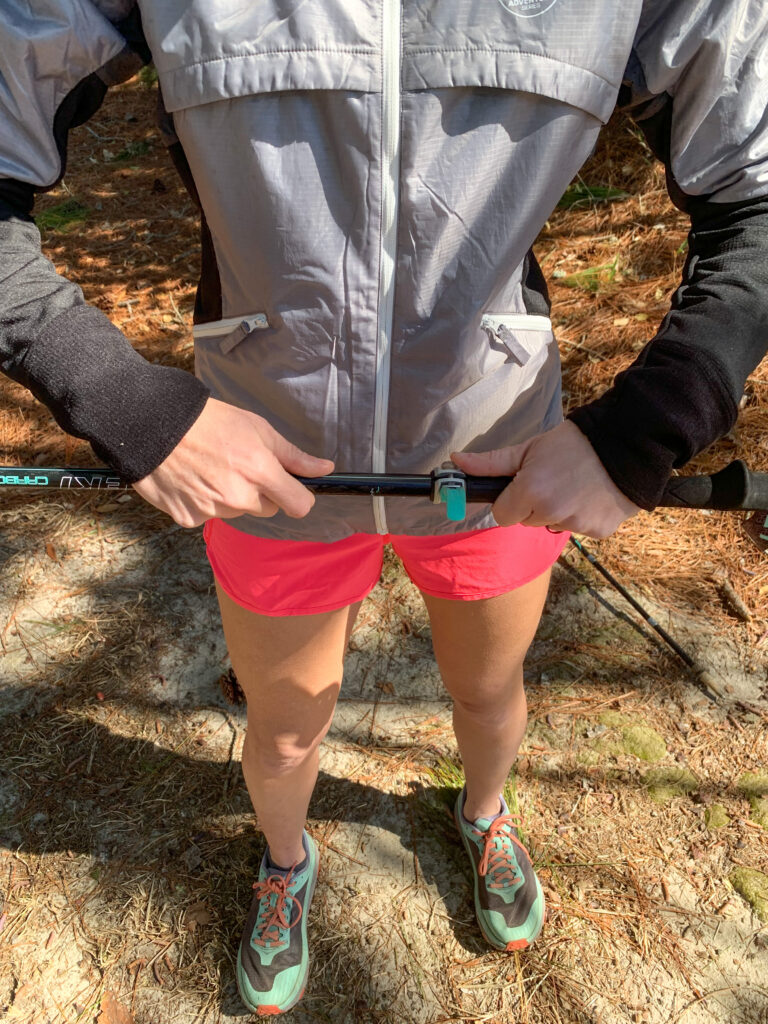
Do Running Poles Make You Faster?
Running poles might make you faster by delaying fatigue while running, but they also might make you slower, if you’re not comfortable or efficient while using them.
Therefore, as I’ve mentioned before and will absolutely mention again, you’ve got to practice with them before race day.
Do Trekking Poles Build Upper Body Strength?
Trekking poles utilize the muscles of your upper body. When you plant the poles into the ground, push your body weight into them, pull your body weight up the hill using them, swing those arms back through to complete the cycle….and repeat over and over…it only makes sense that your upper body is getting a workout too.
In fact, research studies show that when using trekking poles (running or hiking) muscle response (measured by EMG) of the biceps brachii, triceps, deltoid medius, and latissimus dorsi increased upwards of 600% when poles were used compared with when poles were not used. (Je-myung Shim, et al)
6 Best Exercises to Strengthen Your Upper Body for Running With Trekking Poles
Here are 6 exercises you can do at home or in a gym, with dumbells, a kettlebell, or even a gallon jug of water to help strengthen your upper body against trekking pole fatigue
- Pushups
- Pullovers (keep elbows wider to work your back vs. your chest)
- Hammer curls
- Triceps Skull Crushers
- Shoulder Shrugs
- Weighted Dead Bugs
If you’re just starting, aim for 3-4 sets of 8-10 reps, at a weight where you can maintain proper form, but feel fatigue (tired) towards the end of each set.
How to Run With Poles: Top Ten Tips
- Make sure your poles are adjusted to the correct height for use, on the correct type of terrain.
- Try different techniques. Some runners like to alternate pole placement with their natural arm swing. Others prefer to use both arms at once and push through.
- Keep your elbows in closer to your body. This will help make your pole movements more efficient, and will make the poles feel unwieldy.
- When using your poles, be sure to put your hands through the straps. The purpose of the hand strap isn’t so you don’t lose or drop your pole if you let go. Rather, the wrist strap helps take pressure off of your hand, and distribute some of it into your wrist. This allows you to avoid that “white knuckle grip” where you are clenching the grips too hard with your hands.
- If you plan to use your poles for long durations, be aware that it’s not unheard of for your hands to blister. Consider using a glove if this becomes an issue. Trekking pole brands like Leki make gloves specifically for this issue. Or, you could use a lightweight cycling glove instead.
- Watch where you plant your poles, especially on steep terrain. Watch for rocks or holes where the pole may get stuck, or soft mud or sand where the pole may sink lower than expected. You’ll also want to use caution on hard surfaces (such as a big rock face, ice, etc.) as they may slip.
- Always be aware of your surroundings! Avoid swinging the poles wildly (especially if you’re like me, and you talk with your hands). The last thing you want to do is hit another runner with your poles.
- When running with trekking poles in your hand, but not using them, hold both in one hand, ideally with the tips pointing forward. This will help ensure that you are dragging the tip behind you…and that you aren’t accidentally hitting another runner with the sharp tips.
- Speaking of tips, try really hard to NOT loose the plastic covers that come with your poles! These can help prevent the carbide tip of your trekking pole from piercing your hydration pack, or simply becoming a hazard when not in use.
- Remember to practice! Use your trekking poles on occasional training runs and long runs, even if you don’t think you need poles, just to get comfortable with them. The ultimate goal is to nail down your skills and make sure the poles are helpful, not a hindrance.
Heather Hart is an ACSM certified Exercise Physiologist, NSCA Certified Strength and Conditioning Specialist (CSCS), UESCA certified Ultrarunning Coach, RRCA certified Running Coach, co-founder of Hart Strength and Endurance Coaching, and creator of this site, Relentless Forward Commotion. She is a mom of two teen boys, and has been running and racing distances of 5K to 100+ miles for over a decade. Heather has been writing and encouraging others to find a love for fitness and movement since 2009.
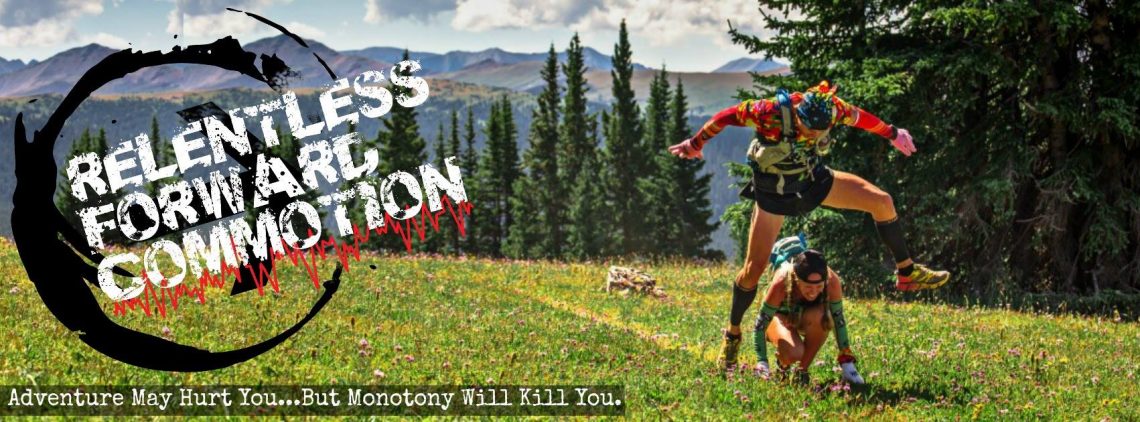
Paul Sommer
Do you recommend running alternating the front and back pole position or use two in front at a tie when running?
I’ve tried both but think alternating is best. What do you suggest/prefer?
Heather Hart, ACSM EP-C
I think it definitely depends on the terrain! I tend to prefer alternating myself, however on some really steep terrain using both at the same time can be beneficial for balance and support.